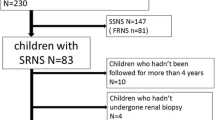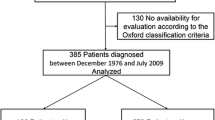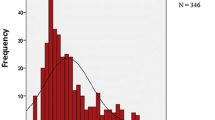Abstract
From January 1985 to July 2000, a retrospective study of 53 patients in Taiwan was performed in order to evaluate the underlying diseases causing heavy proteinuria and the clinical outcome in children under 2 years of age (33 boys and 20 girls). Renal biopsy or autopsy was performed in 26 of the children. Renal pathology revealed 2 patients with congenital nephrosis (CNS) (7.7%), 4 with diffuse mesangial sclerosis (DMS) (15.4%), 4 with minimal change nephrotic syndrome (MCNS) (15.4%), 5 with focal segmental glomerulosclerosis (FSGS) (19.2%), 9 with IgM nephropathy in (34.6%), and 2 with hepatitis B virus-associated membranous glomerulonephritis (7.7%). Based on available histology and family history of heavy proteinuria progressing to end-stage renal disease (ESRD), patients were divided into two groups. Group I comprised 10 patients, including CNS (2 cases), DMS (4 cases), and 4 children with a familial history of heavy proteinuria progressing to ESRD. All patients in group I were initially steroid resistant. After methylprednisolone pulse therapy plus cyclosporin A treatment, no patients with CNS or DMS responded, but the other 4 patients experienced a remission. Group II comprised 43 patients; 19 patients (44.2%) were initially steroid resistant. Of these steroid-resistant patients, all experienced remission after methylprednisolone pulse therapy plus cyclosporin A, except 3 children with FSGS. One experienced a thromboembolic event during his clinical course. In conclusion, steroid-resistant nephrotic syndrome (NS) was more common than steroid-sensitive NS in Chinese patients under 2 years of age. Patients with CNS, DMS, or a family history of heavy proteinuria progressing to ESRD had a poor prognosis. Methylprednisolone pulse therapy plus cyclosporin A treatment achieved remission in some children who were initially steroid resistant. This study indicates that children with conditions associated with poor steroid responsiveness (e.g., CNS, DMS) do not respond to immunosuppressive therapy, but other children under 2 years of age, including those with a family history of progression to ESRD, may benefit from aggressive immunosuppressive therapy.
Similar content being viewed by others
References
Churg J, Sobin H (1982) WHO monograph: renal disease. Classification and atlas of glomerular disease. Igaku-Soin, Tokyo
Lin CY, Chen CM (1986) Studies of circulating immune complexes and lymphocyte subpopulations in childhood IgM mesangial nephropathy. Nephron 44:198–203
Combes B, Stastny P, Shorey J, Engenbrodt EH, Barrera A, Hull AR, Carter NW (1971) Glomerulonephritis with deposition of Australia antigen-antibody complexes in glomerular basement membrane. Lancet 2:234–236
International Study of Kidney Disease in Children (1978) Nephrotic syndrome in children: prediction of histopathology from clinical and laboratory characteristics at time of diagnosis. Kidney Int 13:159–165
Hamed RM, Shomaf M (2001) Congenital nephrotic syndrome: a clinico-pathologic study of thirty children. J Nephrol 14:104–109
Mendelson HB, Krauss M, Berant M, Lichtig C (1982) Familial early-onset nephrotic syndrome: diffuse mesangial sclerosis. Acta Paediatr Scand 71:753–758
Barakat AY, Khoury LA, Allam CK, Najjar SS (1982) Diffuse mesangial sclerosis and ocular anomalies in two sibling. Int J Pediatr Nephrol 3:33–35
Guez S (1998) Adequate clinical control of congenital nephrotic syndrome by enalapril. Pediatr Nephrol 12:130–132
Heaton PA, Smales O, Wong W (1999) Congenital nephrotic syndrome responsive to captopril and indomethacin. Arch Dis Child 81:174–175
Ruotsalainen V, Ljungberg P, Wartiovaara J, Lenkkeri U, Kestila M, Jalanko H, Holmberg C, Tryggvason K (1999) Nephrin is specific located at the slit diaphragm of glomerular podocytes. Proc Natl Acad Sci 96:7962–7967
Kaplan JM, Kim SH, North KN, Rennke H, Correia LA, Tong HQ, Mathis BJ, Rodríguez-Pérez JC, Allen PG, Beggs AH, Pollak MR (2000) Mutations in ACTN4, encoding alpha-actinin-4, cause familial focal segmental glomerulosclerosis. Nat Genet 24:251–256
Yang Y, Zhang SY, Sich M, Béziau A, Van den Heuvel LP, Gubler MC (2001) Glomerular extracellular matrix and growth factors in diffuse mesangial sclerosis. Pediatr Nephrol 16:429–438
Pelletier J, Bruening W, Kashtan CE, Mauer SM, Manivel JC, Striegel JE, Houghton DC, Junien C, Habib R, Fouser L (1991) Germline mutations in the Wilms' tumor suppressor gene are associated with abnormal urogenital development in Denys-Drash syndrome. Cell 27:43–47
Cohen AH, Border WA, Glassock RJ (1978) Nephrotic syndrome with glomerular mesangial IgM deposition. Lab Invest 38:610–619
Zeis PM, Kavazarakis E, Nakopoulou L, Moustaki M, Messaritaki A, Zeis MP, Nicolaidou P (2001) Glomerulopathy with mesangial IgM deposits: long-term follow up of 64 children. Pediatr Int 43:287–292
Lin JT, Lin CY, Huang FY, Lee PP, Chen CH, Hsu HC (1995) A clinicopathological study of idiopathic nephrotic syndrome in children. Jpn J Nephrol 37:442–450
Pardo V, Riesgo I, Zilleruelo G, Strauss J (1984) The clinical significance of mesangial IgM deposition and mesangial hypercellularity in minimal change nephrotic syndrome. Am J Kidney Dis 3:264–269
Habib R, Girardin E, Gagnadoux MF, Hinglais N, Levy M, Broyer M (1988) Immunopathological findings in idiopathic nephrosis: clinical significance of glomerular " immune deposits". Pediatr Nephrol 2:402–408
Chen WP, Lin CY, Hsu HC, Ching H (1988–1989) Childhood nephrotic syndrome and heavy proteinuria in Taiwan. A retrospective clinicopathologic study. Child Nephrol Urol 8:57–64
Lin CY (1995) Treatment of hepatitis B virus-associated membranous nephropathy with recombinant alpha-interferon. Kidney Int 47:225–230
Author information
Authors and Affiliations
Corresponding author
Rights and permissions
About this article
Cite this article
Chang, JW., Lin, CY. Long-term outcome of heavy proteinuria in patients under 2 years of age. Pediatr Nephrol 18, 1044–1048 (2003). https://doi.org/10.1007/s00467-003-1238-6
Received:
Revised:
Accepted:
Published:
Issue Date:
DOI: https://doi.org/10.1007/s00467-003-1238-6




